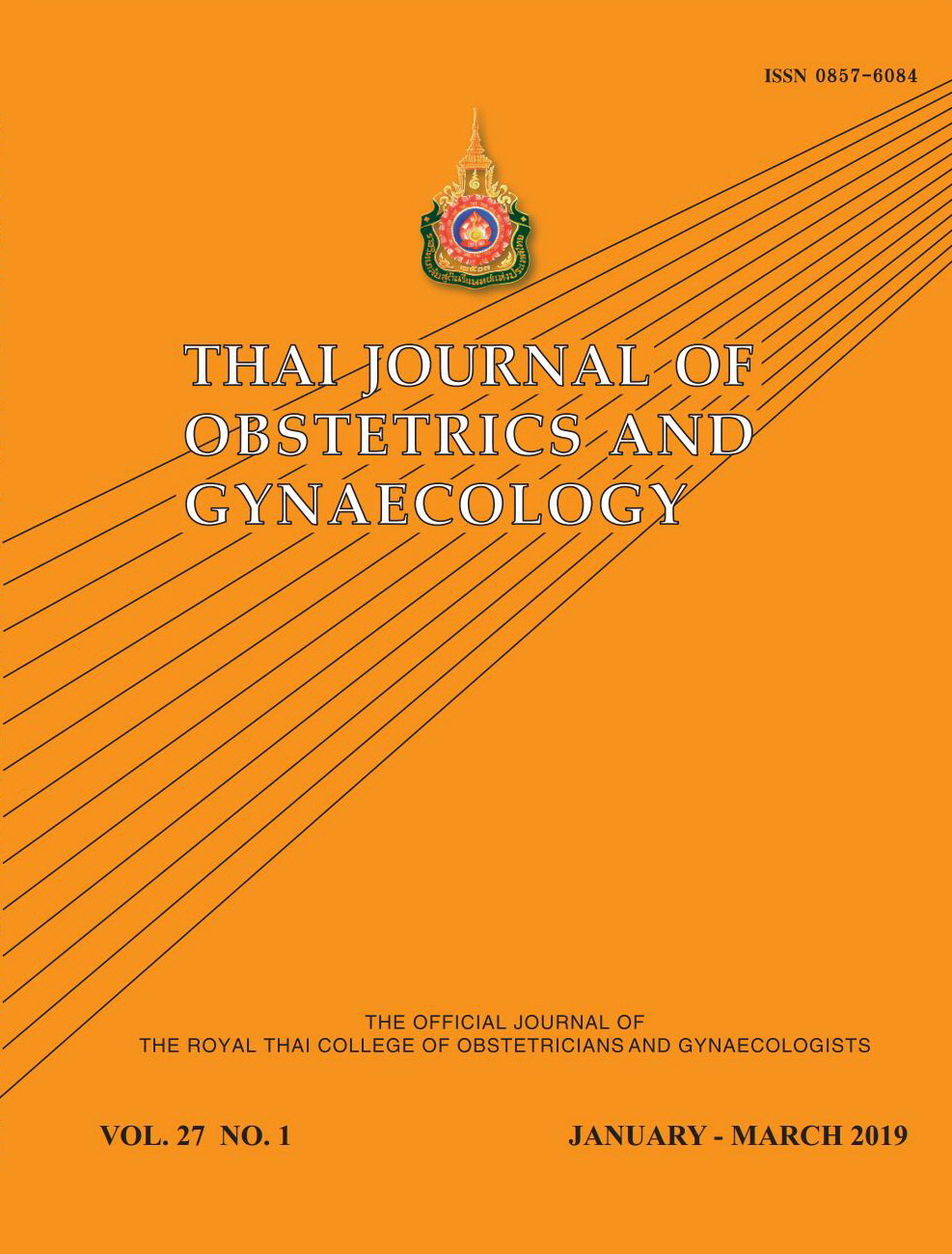Prevalence and Risk Factors of Birth Asphyxia among Elderly Gravidarum
Main Article Content
Abstract
Objectives: To investigate the prevalence and risk factors of birth asphyxia in pregnancies with advanced maternal age.
Materials and Methods: This study involved a retrospective cohort with a nested case-controlled study. Data were collected at Rajavithi Hospital. The prevalence of birth asphyxia was investigated using a retrospective cohort study of cases from January 2012 to June 2016. Antepartum factors, intrapartum factors and postpartum and newborn factors were studied using a nested case-controlled approach that involved the random matching and analysis of the results according to these factors.
Results: The prevalence of birth asphyxia of advanced maternal age group in this study was 11.7%. The statistically significant risk factors included number of antenatal care (ANC) < 4 visits (adjusted OR 1.64, 95% CI 1.18-2.26), hypertensive disorders (adjusted OR 1.94, 95% CI 1.42 -2.65), placenta previa (adjusted OR 4.58, 95% CI 2.74-7.68), PROM > 18 hours (adjusted OR 3.71, 95% CI 1.98 – 6.98), non-cephalic presentation (adjusted OR 1.95, 95% CI 1.34-2.84), and non-reassuring intrauterine fetal status (adjusted OR 3.35, 95% CI 2.22-5.06). There were no significant risk factor at diabetes disorders (95%CI 0.84-1.42, p = 0.50), meconium stained amniotic fluid (95%CI 0.64-1.73, p = 0.830), administration of analgesic drug (95%CI 0.59-1.91, p = 0.839), and nuchal cord (95%CI 0.59-1.27, p = 0.453).
Conclusions: Birth asphyxia at Rajavithi Hospital was 11.7%. The statistically significant risk factors associated with birth asphyxia were number of ANC < 4 visits, hypertensive disorders, placenta previa, a PROM > 18 hours, non-cephalic presentation, and non- reassuring fetal status or fetal distress.
Article Details
References
2. Marai W, Lakew Z. Pregnancy outcome in the elderly gravida in Addis Ababa. East Afr Med J. 2002;79(1):34-7.
3. Bayrampour H, Heaman M, Duncan KA, Tough S. Advanced maternal age and risk perception: a qualitative study. BMC Pregnancy Childbirth. 2012;12:100.
4. Laopaiboon M, Lumbiganon P, Intarut N, Mori R, Ganchimeg T, Vogel JP, et al. Advanced maternal age and pregnancy outcomes: a multicountry assessment. BJOG. 2014;121 Suppl 1:49-56.
5. World Health Organization. International statistical classification of diseases and related health problems -10th revision. 2. Geneva: WHO; 2010.
6. Department of Health, Ministry of Public Health, Thailand. 2010 Annual report. Bangkok: Ministry of Public Health, 2011: 25-26.
7. Aslam HF, Saleem S, Saleem SF, Afzal R, Afzal RF, Iqbal U, et al. Risk factors of birth asphyxia. Italian Journal of Pediatrics 2014;40:1-9.
8. Nayeri F, Shariat M, Dalili H, Bani Adam L, Zareh Mehrjerdi F, Shakeri A. Perinatal risk factors for neonatal asphyxia in Vali-e-Asr hospital, Tehran-Iran. Iran J Reprod Med. 2012;10(2):137-40.
9. Chiabi A, Nguefack S, Mah E, Nodem S, Mbuagbaw L, Mbonda E, et al. Risk factors for birth asphyxia in an urban health facility in cameroon. Iran J Child Neurol. 2013;7(3):46-54.
10. Cunningham FG, Leveno KL, Bloom SL, Spong CY, Dashe JS, Hoffman BL, et al. Amnionic fluid. Williams obstetrics. 24th ed. New york: McGraw Hill. 2014; 233.
11. Chanputthivet A. Effect of Birth Asphyxia in Term Neonates. Queen Sirikit National Institue of Child Health T, Digital library 2003:1-4.
12. Puernngooluerm P. Factors influenced birth asphyxia in term pregnancies at Maharat Nakorn Ratchasima Hospital. Health Science Journal in Thailand. 2010;25(3):1-14.
13. Strategy and Planning Division, Ministry of Public Health, Thailand. Strategy and KPI in year 2016. Bangkok: Ministry of Public Health, Thailand, 2015: 42-48.
14. Majeed R, Memon Y, Majeed F, Shaikh NP, Rajar UD. Risk factors of birth asphyxia. J Ayub Med Coll Abbottabad. 2007;19(3):67-71.
15. Techasena W. Risk factors for Birth Asphyxia in Nan Province. Uttaradit Hospital Medical Journal 2012;27(2):53-64.
16. Suwannachart B. Risk factors for birth asphyxia In Kalasin Hospital. Srinagarind Med J. 2004;19(4):233-40.
17. Pitsawong C, Panichkul P. Risk factors associated with birth asphyxia in Phramongkutklao Hospital. RTA Med J. 2011;64(3):109-19.


